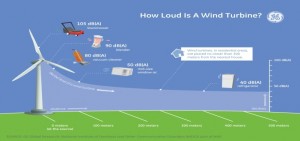Environment
Environmental Benefits:
- Wind energy produces no harmful greenhouse gas emissions that pollute the air
- Wind energy is a domestic source of energy, and the nation’s wind supply is abundant
- Wind energy reduces water consumption
- Wind turbines produce relatively low noise levels
Reduced Greenhouse Gas Emissions:
Wind energy is powered by the wind, so it is a clean source of energy. Wind energy emits no carbon dioxide or other greenhouse gases during operation, so it does not pollute the air like power plants that rely on combustion of fossil fuels. The only time carbon dioxide is released is during manufacturing and maintenance procedures of the turbines. [1]
Electricity produced by a wind turbine results in an equivalent decrease in electricity production at another power plant. In 2013, wind energy made up 4.1% of U.S. energy generation and over 96 million metric tons of carbon dioxide was avoided from emission to the atmosphere. This is the equivalent of reducing power sector carbon dioxide emissions by 4.4%. The graph below shows the amounts of carbon dioxide that have been avoided from emission over the past 13 years due to wind energy. [2]
Reduced Water Consumption:
Wind energy use can reduce water consumption by decreasing use of fossil fuel power plants that use water as a coolant. In 2013, fossil fuel powered plants reduced water consumption by 36.5 billion gallons as a result of wind energy generation. This is the equivalent of roughly 116 gallons per person in the U.S. [2]
Turbine Noise Levels and Wildlife Effects:
Noise levels are a large concern surrounding wind energy use because nobody wants to live near a device that makes loud noise 24/7. There are laws about the proximity turbines can be built to homes. A turbine cannot be built within 300 meters of a home. At that distance, the noise level from one turbine is 45 dB. This is a rather low noise level compared to city traffic noise of 90 dB. The graph below shows noise level comparison to other household devices. [3]
Bird deaths are another concern surrounding wind energy use. Turbines reportedly kill between 20,000 and 37,000 birds a year in the U.S. Compared to the 90 million birds that die from buildings and 130 million that die from power lines each year, the number of deaths from turbines is low. [1]
Future Outlook:
The Department of Energy found a 20% wind energy generation by 2030 technically and economically feasible. [2] According to the American Wind Energy Association, achieving this wind energy capacity would have the following environmental effects:
- Cumulatively 7,600 million tons of carbon dioxide would be avoided by 2030, and more than 15,000 million tons would be avoided by 2050
- Cumulative water consumption in the electric sector would be reduced by 8%
- Natural gas demand will reduce and its price will reduce by 12%, which will reduce natural gas emissions
References
1) “Wind Turbines.” Wind Turbines. Wind Measurement International, n.d. Web. 13 Apr. 2014.
2) “Wind Energy & Reducing Greenhouse Gas Emissions.” Www.awea.com. N.p., n.d. Web. 15 Apr. 2014. <http://awea.rd.net/Resources/Content.aspx?ItemNumber=5097>.
3) “How Loud Is A Wind Turbine?” GE Global Research. N.p., n.d. Web. 15 Apr. 2014. <http://www.darvill.clara.net/altenerg/images/large-wind-turbine.jpg>.
Primary Author: Stephen Schappert
Primary Editor: Ryan Younis


